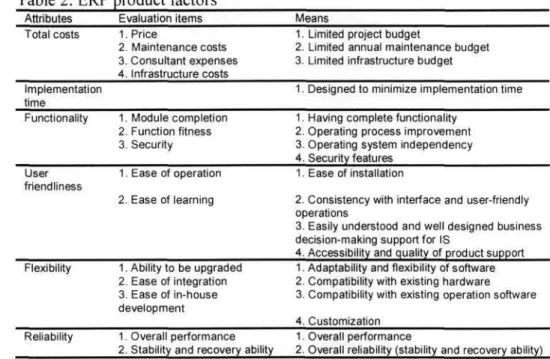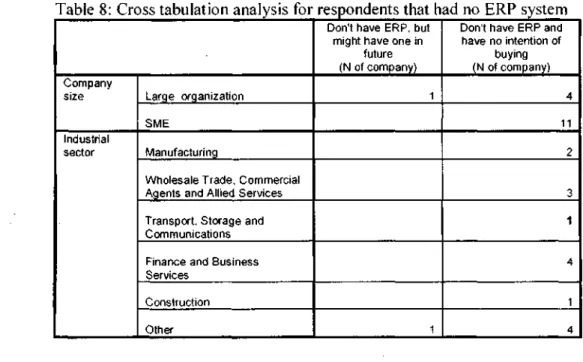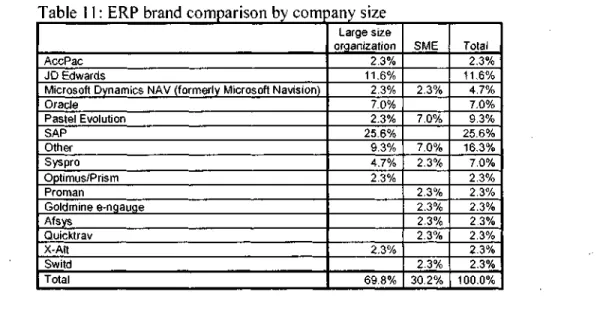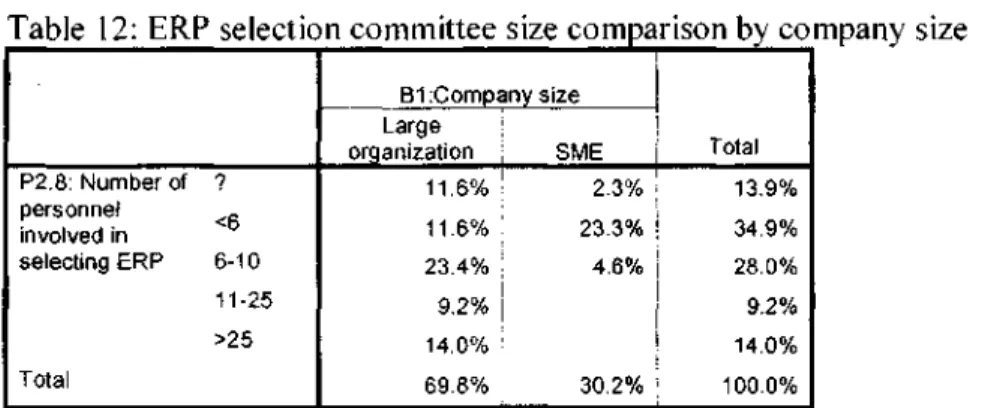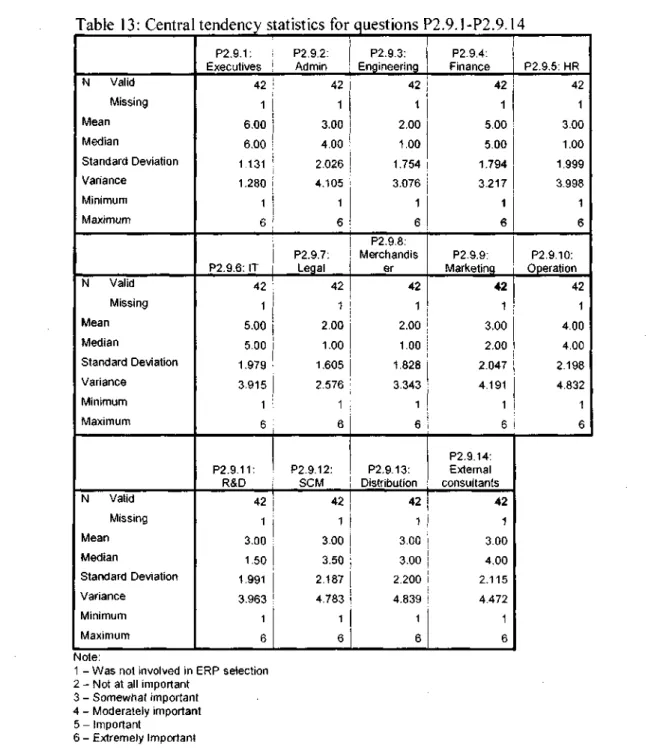The purpose of this study was to examine the current ERP selection processes used by KwaZulu-Natal organizations to determine which problem factors were evidenced during the selection process. In order to obtain a KwaZulu-Natal organization's perspective of the ERP selection process, two phases were used to collect survey data.
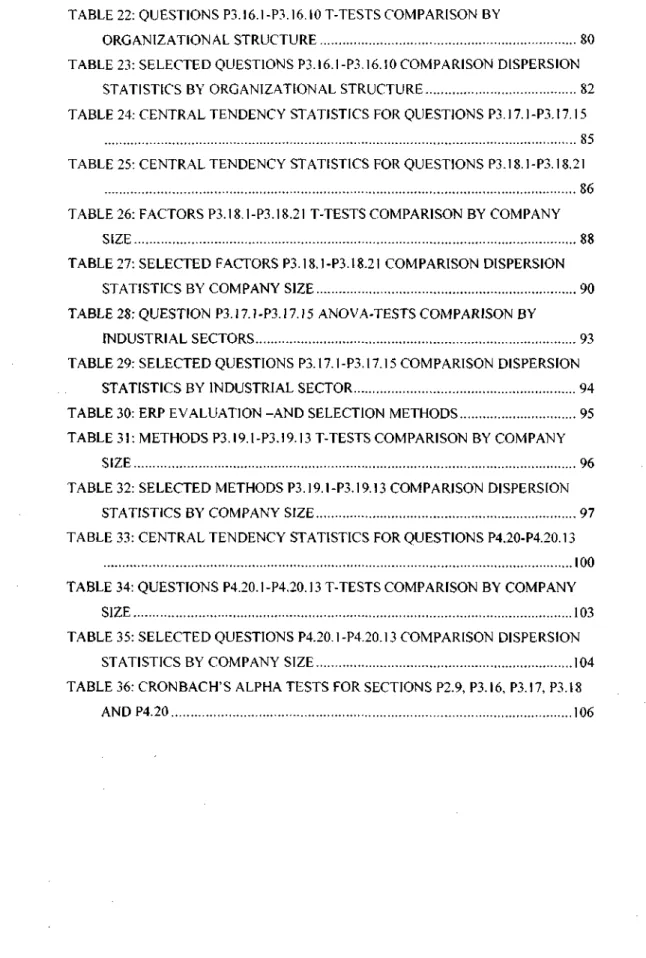
INTRODUCTION
There has been an increase in the number of companies adopting ERP systems worldwide. The aim of this research is therefore firstly to investigate the current ERP selection processes used by KwaZulu-Natal (KZN) organisations.
BACKGROUND AND CONTEXT
Brief History of ERP
The idea of ERP was born in the early 1960s as a direct result of companies' need to keep a "just-in-case" inventory to check actual as well as assumed inventory levels. In the 1980s, the extension of the MRP system to include other parts of productive systems was a natural development and to be expected.
Current Trends for ERP
Instead, their evolution over the last three decades shows that the future evolution and development of ERP systems can still be expected for some time. The next section of this chapter will reveal the future trends that can be expected with ERP systems.
The Term "ERP"
Furthermore, with further improvements and mature industrial standardizations in the software, ERP projects will take less time to implement in the future. Therefore, the ERP evaluation and selection models will gain much more importance in the future, and companies will be able to justify their investments effectively.
STATEMENT OF PROBLEM
Moreover, 'more than 25% of the managers in the organizations they studied did not know whether IT/IS investments were better or worse than non-IT/IS investments. In summary, there is a need to provide managers with an easy-to-use ERP selection and evaluation tool because the "high rate of IT/IS failure is partly attributable to a lack of solid, but easy-to-use , management tools for evaluating, prioritizing, monitoring and controlling IT/IS investment*(Chou, 2006).
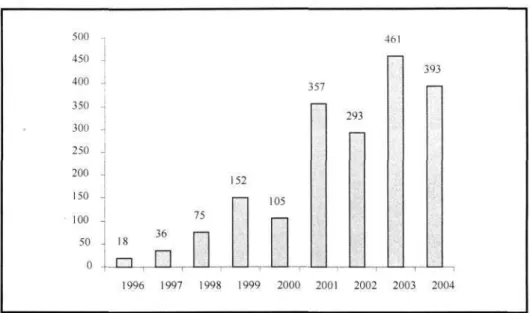
SIGNIFICANCE OF THE STUDY
In addition, there are many debates advocating different methodologies, approaches and frameworks for conducting effective ERP selection and evaluation. In short, the practice of selecting and evaluating ERP systems has become an increasingly complex and difficult task for business management.
RESEARCH OBJECTIVES AND QUESTIONS
By what criteria and methodologies do companies in KZN evaluate and select appropriate ERP software packages. Do the measurement criteria and selection processes differ in SMEs and large organizations in KZN?
DISSERTATION OVERVIEW
- Chapter One
- Chapter Two
- Chapter Three
- Chapter Four
- Chapter Five
This chapter provides a literature review and background information on ERP evaluation and selection studies. Much of the discussion in this chapter will revolve around attempting to address the research questions regarding ERP selection and application status in KZN.
CONCLUSION
INTRODUCTION
The reasons for the failure of ERP systems highlighted above have led many researchers to try to combine various theories and techniques to develop a broader or more appropriate approach or a more comprehensive framework to aid in ERP evaluation – and selection decisions. Unfortunately, there is still no common agreement in academia or industry regarding an ERP evaluation and selection framework, nor could such an approach be found in the literature reviewed for this study.
ERP MEASUREMENT CONTENT
34; Acknowledgment of the intended outcomes of the evaluation also requires explanation if effectiveness is to be achieved* (Stockdale & . Standing, 2006). In this section of Chapter Two, the study will briefly summarize previous ERP system evaluation and selection decision-making frameworks and approaches, describe the evaluation and selection measurement criteria and stakeholders, and then discuss the limitations of the most appropriate ERP selection frameworks and approaches.
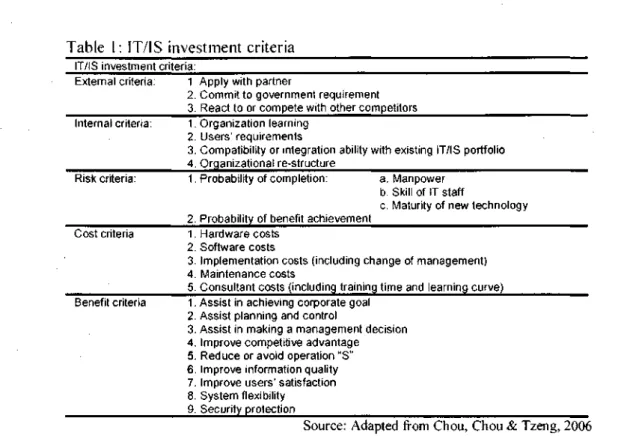
ERP EVALUATION AND SELECTION STAKEHOLDERS
Their argument is that understanding who conducts the ERP evaluation process could explain to some extent why the intended outcome of the evaluation might be recognized and help explain whether the evaluation and selection process was effective or not. The group of end users – employees who actually work on the ERP system with daily actions that affect the outcome of the ERP system – will not be the main focus of this study as a whole, because they usually cannot influence the ERP selection decision.
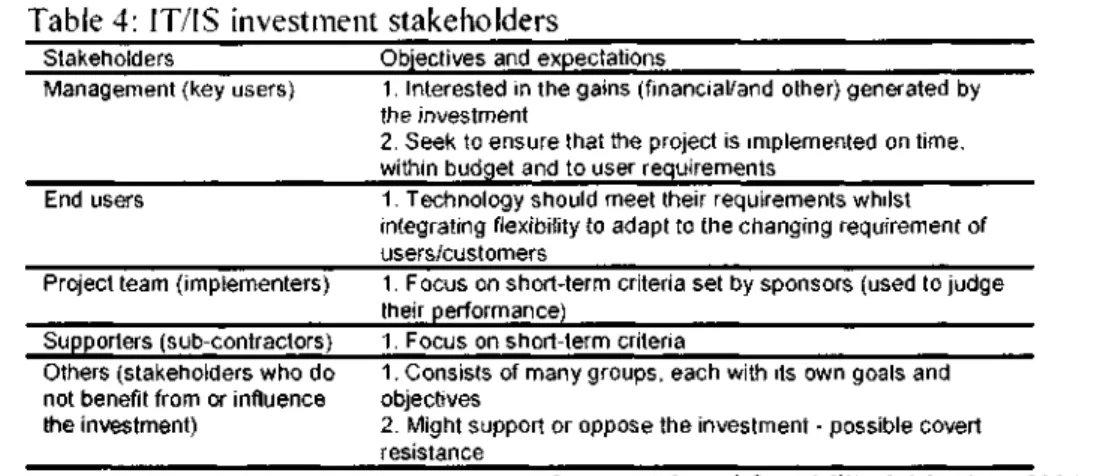
ERP EVALUATION AND SELECTION PROCESS
Financial and Ratio Approach
These methods focus on cash inflows and outflows as a result of the investment made (Renkema & Berghout, 1997). Valuing innovation: additional cash flows arising from the innovative aspects of the investment (e.g. competitive advantage).
Multi-Criteria Approach
Will the ERP project create, deliver and maintain support for our product and service in an efficient manner. Is the ERP project meeting our goals and contributing value to the organization as a whole.
Hierarchical Process Approach
It provides a useful mechanism to check the consistency of the ERP evaluation and selection measures and potential alternatives, reducing bias and time in decision making. A hierarchical process allows organizations to minimize some of the common pitfalls in the decision-making process, such as lack of focus, planning, participation.
CONCLUSION
Chapter Three explains how this research was conducted and the steps used in the survey study.
INTRODUCTION
RESEARCH DESIGN
- Negotiating Access and Research Ethics
- Sample Selection
- Data Collection
- Data Analysis
- Limitations of the Study
Factors that contribute to this situation include: the time of year when the survey was conducted. The questionnaire also included details of the researchers' and supervisors' names and contact details to ensure the legitimacy of the research.
CONCLUSION
Researchers may not be able to conduct a 'perfect' survey, but they are expected to have a broad understanding of the limitations of their research and to make reasonable arrangements for the time and resources they devote to the research have (Leedy & Ormrod, 2005). As previously pointed out, this study was limited to organizations in the KZN province of SA due to the limitations on research resources (budget and time).
RESPONDENTS BACKGROUND
Other respondents indicated that they did not have an ERP system and were not involved in selecting ERP software. A Study of Problem Factors in ERP Selection from KwaZulu-Natal Organizations July 2007. answered only part one of the questionnaire as they had no ERP system and did not intend to purchase one.
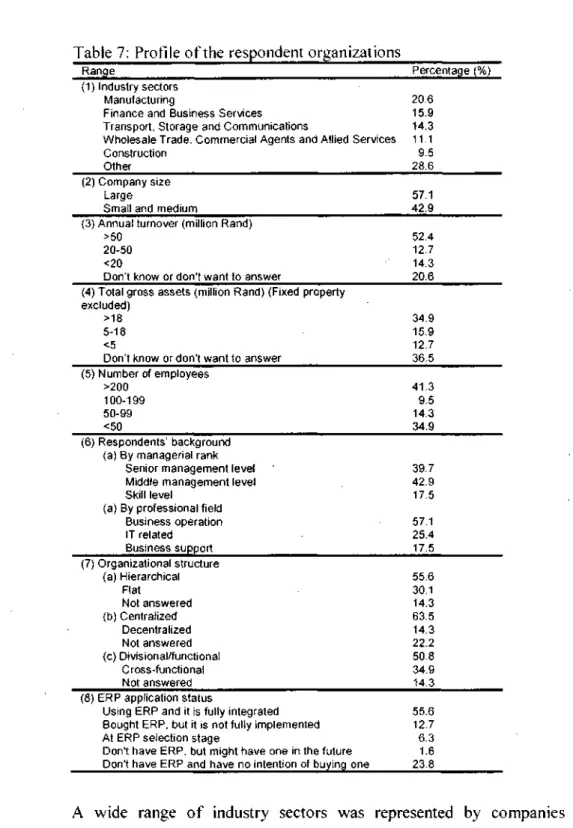
ERP SYSTEM APPLICATION STATUS
A further cross analysis of ERP brand by company size is shown in Table 11 below. The remaining ERP brands, including Microsoft Dynamics NAV, Pastel Evolution and Syspro, are used by both large organizations and SMEs.
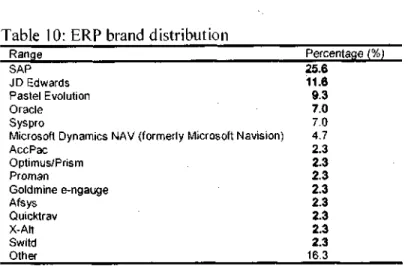
SELECTION COMMITTEE STRUCTURE
Comparison by Company Size
Was not involved in ERP selection Not at all important Somewhat important Moderately important Important Extremely important Total. Was not involved in ERP selection Not at all important Somewhat important Moderately important Important.
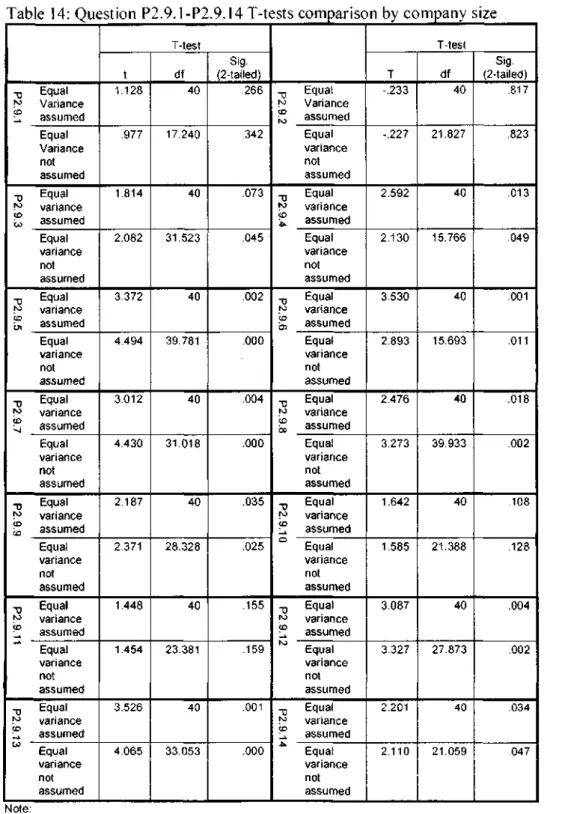
Comparison by Industrial Sector
P2.9.3 Was not involved in ERP selection Not important at all Somewhat important Moderately important Important Extremely important Total. P2.9.6 Was not involved in ERP selection Not important at all Somewhat important Moderately important Important Extremely important Total.
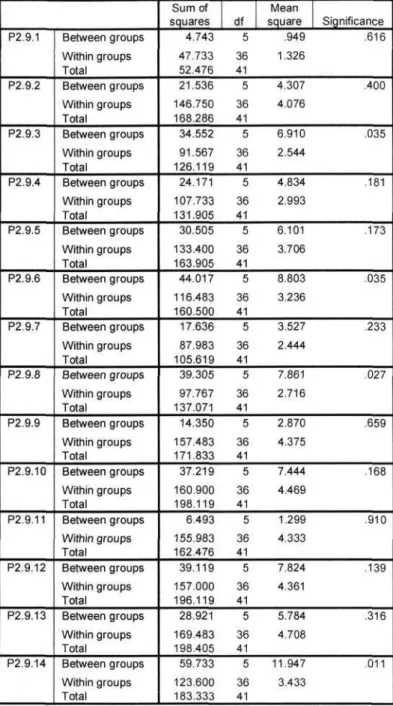
Brief Summary
INFORMATION GATHERING
Based on this information, you might assume that large organizations have more financial resources, knowledge resources, and know-how when engaging in an ERP selection project.
ERP SELECTION PROBLEMS
- Comparison by Company Size
- Comparison by Industrial Sector
- Comparison by Organizational Structure
- Brief Summary
To get a detailed picture and thus show the differences identified in Table 20, a cross-tabulation analysis was performed using comparative scatter statistics for questions P3.16.1 and P3.16.9. This difference in perception on question P3.16.1 could be explained if SMEs and large organizations focus on different ERP products.
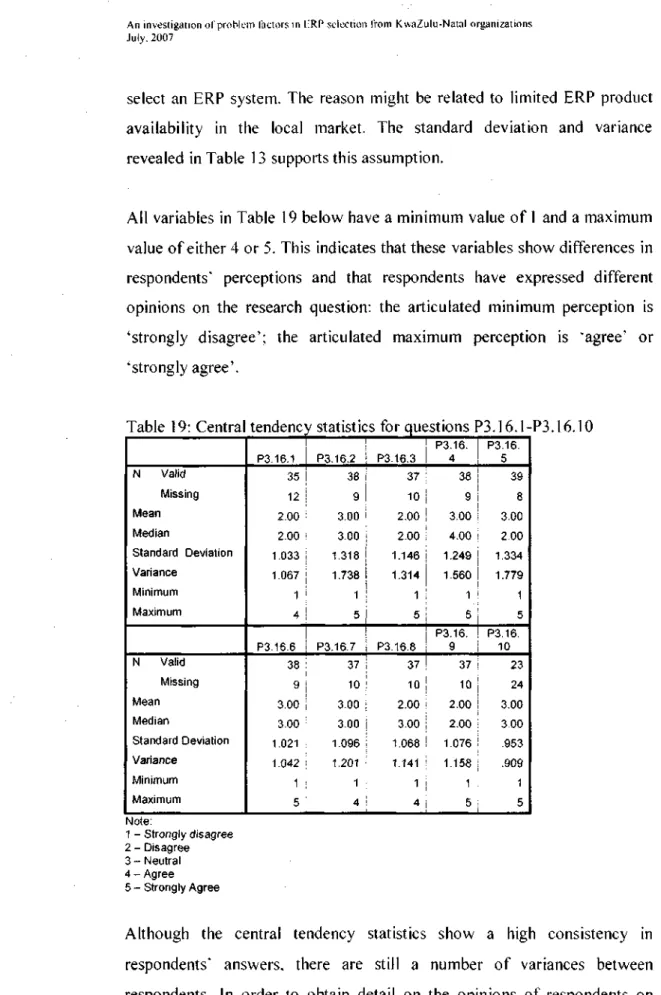
SELECTION CRITERIA
Comparison by Company Size
36% of respondents from large organizations rated factor P3.18.1 as important or extremely important; compare this with SMEs, where only 14.2% of respondents were of the same opinion;. Another problem may be that ERP accessibility required by suppliers and customers is higher in large organizations and thus the internationality of ERP software (P3.18.11).
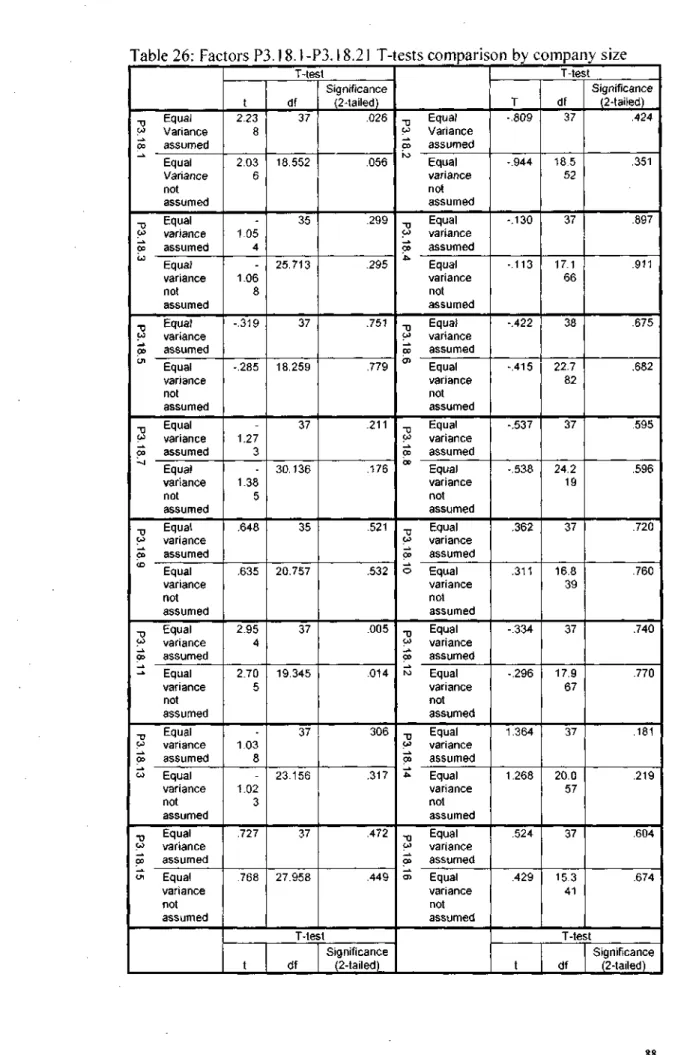
Comparison by Industrial Sector
The largest difference revealed in Table 29 that in the financial and business services industry, 19.8% of respondents rated the factor P3.17.7 as "not at all important". Manufacturing Wholesale trade, commercial agents and related services Transport, warehousing and communication Finance and business services Building and construction Other.
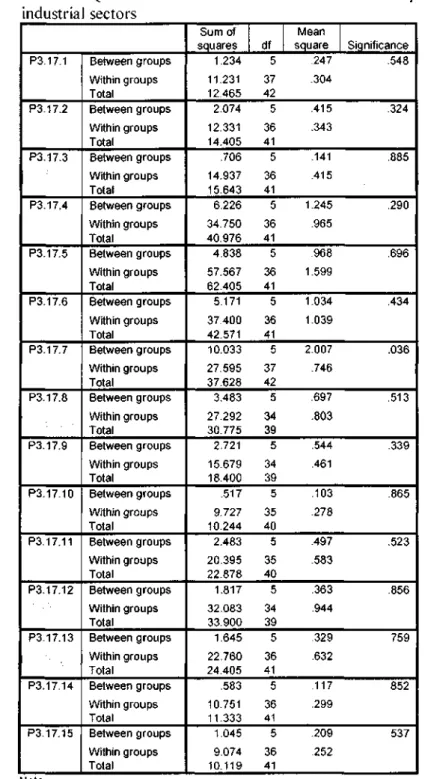
Brief Summary
METHODS USED IN DECISION PROCESS
Equal variances assumed Equal variances not assumed Equal variances assumed Equal variances not assumed Equal variances assumed Equal variances not assumed Equal variances assumed Equal variances not assumed Equal variances assumed Equal variances assumed Equal variances not assumed Equal variances not assumed Equal variances not assumed Equal variances assumed Equal variances ed Equal deviations are not assumed. Equal variances assumed Equal variances not assumed Equal variances assumed Equal variances not assumed Equal variances assumed Equal variances not assumed Equal variances assumed Equal variances not assumed Equal variances assumed Equal variances assumed Equal variances not assumed Equal variances assumed Equal variances not assumed Equal variances assumed Equal variances not assumed Equal variances not assumed Equal variances not assumed Equal variances not assumed Equal variances not assumed Equal variances not assumed Equal variances not assumed.
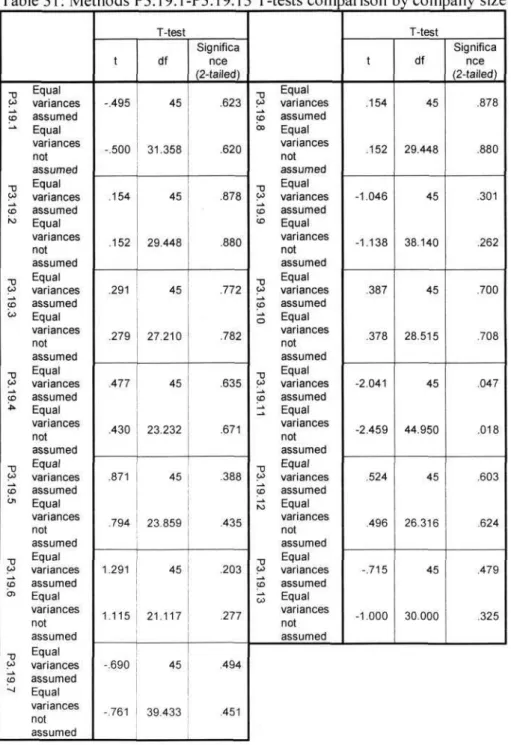
ERP IMPLEMENTATION OR USAGE PROBLEMS
Comparison by Company Size
This means that respondents from large organizations and SMEs have different perceptions of these specific ERP selection problems and that the differences of opinion are large. This perhaps reveals that the ERP selection process was not given enough attention by employees in large organizations and that the problem arose after implementation.
Brief Summary
RELIABILITY STATISTICS
INTRODUCTION
RECOMMENDATIONS
ERP selection and evaluation approaches and methods must effectively and efficiently support ERP selection decision-making. According to the results of the survey, ERP selection and evaluation approaches and methods adopted by KZN organizations were poorly applied in KZN organizations.
LIMITATIONS
Identify the specified needs of the organization and the critical requirements for the functionality of the ERP system and, most importantly, prepare a financial plan and budget for the ERP project. A suggestion for future research on this topic is that attention should be paid to increasing the sample size and expanding the geographic coverage of the sample.
CONCLUSION
I am conducting dissertation research on Enterprise Resource Planning (ERP)* software selection as a final MBA requirement at the University of KwaZulu-Natal. In this survey, businesses in KwaZulu-Natal will be asked to complete a questionnaire about the process the business has gone through or will go through to choose an ERP system.
INFORMATION ABOUT THE COMPANY
Code: PI.6) o Yes, we are using one and it is fully integrated into our company's operating system.
ONLY FOR THOSE COMPANIES THAT HAVE ALREADY PURCHASED AN ERP SYSTEM
If your company purchased ERP software but did not take full advantage of it, what is the reason your company was not using it.
FOR THOSE COMPANIES THAT HAVE ALREADY PURCHASED AN ERP SYSTEM AS WELL ASFOR COMPANIES
The large number of ERP software products available on the market leads to difficulties in comparison (code: P3.16.6). I'm not sure if our existing operational problems were caused by a lack of an ERP system (code: P3.I6.7).
ONLY FOR THOSE COMPANIES THAT HAVE PURCHASED AN ERP SYSTEM
Your answer in ZAR (answer must be a number) Thank you again for helping me with this survey.
